
 |
Tea Clipper |
 |
| from TeaAntiques.com | ||
| Edition Seventy Two |
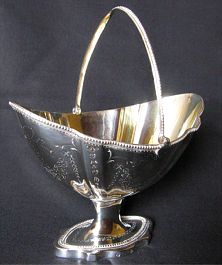 A
most handsome George III sterling silver sugar basket, with shaped boat bowl on
a pedestal foot and swing handle, made in London 1786.
A
most handsome George III sterling silver sugar basket, with shaped boat bowl on
a pedestal foot and swing handle, made in London 1786.
The sugar basket's bowl and foot are beautifully decorated with contemporary bright-cut decoration. There is applied bead decoration to the rim of the basket, handle and round the foot. The inside of the sugar basket is gilded.
The appearance of this sugar basket is very elegant, the bright cut engraving is delicate with swags of flowers.
The oval bowl of the basket is beautifully shaped with four segmented panels. The pedestal foot is raised upon a rim which echoes the same shape as the basket's bowl.
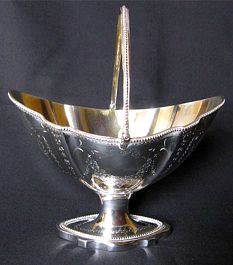
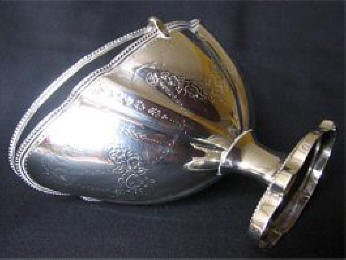
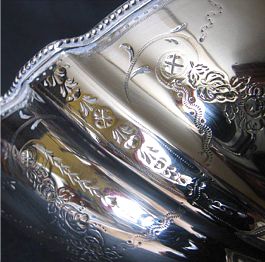
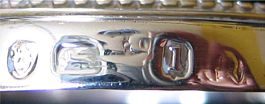 The
sugar basket is hallmarked on one side of the raised foot. These marks include the
Crowned Leopards Head Mark of the London Assay Office; Lion Passant Mark for Sterling
Silver, Date Letter 'l' for 1786 and the Sovereigns Head Duty Mark of King George
III. There is also a makers mark, which I think is struck up-side-down and appears
to be 'B.W', but this mark is slightly worn.
The
sugar basket is hallmarked on one side of the raised foot. These marks include the
Crowned Leopards Head Mark of the London Assay Office; Lion Passant Mark for Sterling
Silver, Date Letter 'l' for 1786 and the Sovereigns Head Duty Mark of King George
III. There is also a makers mark, which I think is struck up-side-down and appears
to be 'B.W', but this mark is slightly worn.
This is certainly a beautiful George III sugar basket for the collector of fine quality English eighteenth century silver.
More details of this item and other tea related antiques can be found by visiting my web site at www.TeaAntiques.com.
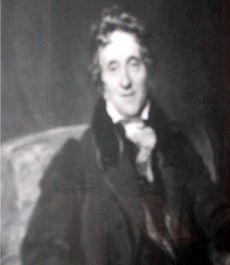 Sir
John Soane (1753-1837), the celebrated architect who built such grand buildings
as the Bank of England in the city of London and who built his own house in the
city in Lincoln's Inn Fields, also owned a rural villa to the West side of London,
which he designed and decorated in his individual style.
Sir
John Soane (1753-1837), the celebrated architect who built such grand buildings
as the Bank of England in the city of London and who built his own house in the
city in Lincoln's Inn Fields, also owned a rural villa to the West side of London,
which he designed and decorated in his individual style.
His house in Lincoln's Inn Fields, which he designed and built in 1812, was his main residence in which he lived and worked. It housed his vast collection of antiquities, sculptures and paintings and is now a popular museum that is open to the public. However, he also designed himself a Georgian villa out to the West in Ealing, a house in which he could entertain rather than live.
Soane purchased the original house of Pitzhanger Manor in 1800 from the Gurnells. The old house was considered and described by Soane as 'an incongruous mass of buildings deficient in symmetry and character'. At the Soane's museum in Lincoln's Inn fields, there are over one hundred plans that Soane drew up for the redesign of Pitzhanger Manor, the earliest dating from 1800-1802. there are also many surviving bills from craftsmen and notebooks that were kept by Soane and his wife that give a good insight into the building of Pitzhanger between 1800-11.
When Soane took over the house, there were many outbuildings and the house itself had a large two storey wing that had been added by architect Charles Dance. Soane demolished many of the outbuildings and the older part of the Gurnell house, but retained the Dance extension, which he incorporated into his own design.
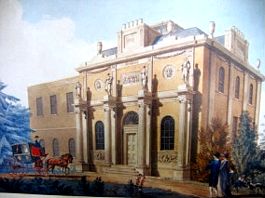
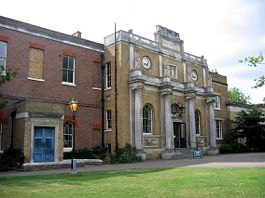 Pitzhanger
was bought, together with its grounds of 28 acres, for £4,500. The gardens contained
a walled vegetable garden, now a rose garden in the public park and also had a small
lake, lawns and woodland. Looking at the front elevation (East Front) of the house
today you can identify the Dance wing to the left in red brick, designed in 1768
and adjoining it, the Soane's designed Villa in 'white' (or yellow) brick, 1800-03.
The yellow brick built villa is enriched with some stone architectural features
including the four giant Ionic columns incorporated into the facade. The statues
that surmount the columns are not stone, but 'Coade stone', a clever artificially
made stone. These statues were inspired by statues on the Temple of Pandrosus in
Athens. This strong architectural use of columns and statues are typical of Soane's
designs. Also incorporated into the design of the front, are some built in reliefs
of a classical nature, again these inspired from a building in Athens, this time
the Temple of Bacchus. The block to the right of Soane's yellow brick Villa was
a later addition by owner after Soane, between 1844-1900. In Soane's time this area
contained a colonnade of ancient columns linking to the servant wing.
Pitzhanger
was bought, together with its grounds of 28 acres, for £4,500. The gardens contained
a walled vegetable garden, now a rose garden in the public park and also had a small
lake, lawns and woodland. Looking at the front elevation (East Front) of the house
today you can identify the Dance wing to the left in red brick, designed in 1768
and adjoining it, the Soane's designed Villa in 'white' (or yellow) brick, 1800-03.
The yellow brick built villa is enriched with some stone architectural features
including the four giant Ionic columns incorporated into the facade. The statues
that surmount the columns are not stone, but 'Coade stone', a clever artificially
made stone. These statues were inspired by statues on the Temple of Pandrosus in
Athens. This strong architectural use of columns and statues are typical of Soane's
designs. Also incorporated into the design of the front, are some built in reliefs
of a classical nature, again these inspired from a building in Athens, this time
the Temple of Bacchus. The block to the right of Soane's yellow brick Villa was
a later addition by owner after Soane, between 1844-1900. In Soane's time this area
contained a colonnade of ancient columns linking to the servant wing.
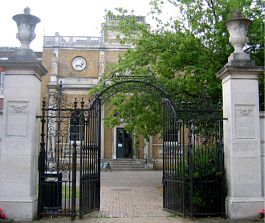
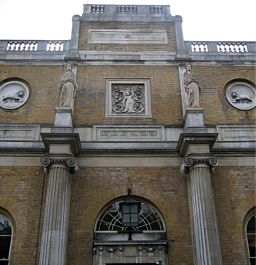
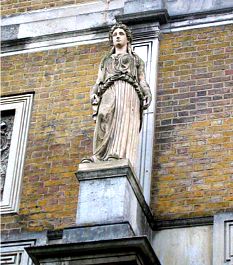
Entering the house through the door on the East front leads into what is a relatively small Vestibule. Soane made this into quite a dramatic entrance by the raising of the ceiling to the first floor level with a large plaster flower in the centre of it. There are also large roundels of classical relief incorporated into the higher walls and archways for dramatic effect.
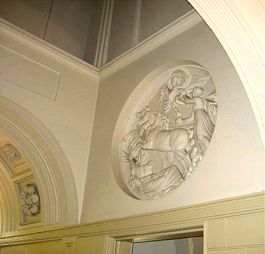
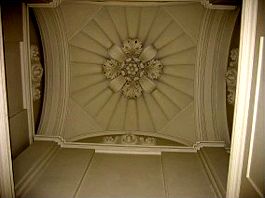
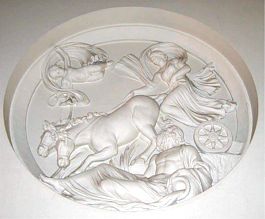
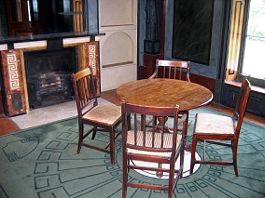 Turning
right, the first room you enter is the Breakfast room. This immediately strikes
you as a Soane's interior design, with his use of many strong colours, textures,
architectural features and use of curves - in this case in the shape of the ceiling,
alcoves and window. It is such features that make this recognisable as a Soane's
design.
Turning
right, the first room you enter is the Breakfast room. This immediately strikes
you as a Soane's interior design, with his use of many strong colours, textures,
architectural features and use of curves - in this case in the shape of the ceiling,
alcoves and window. It is such features that make this recognisable as a Soane's
design.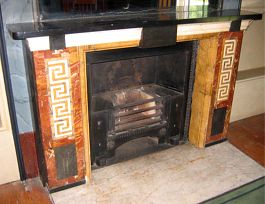 Here, he has used to great effect the ideas of marbling the walls and decoration
that was inspired from the decoration found in a Roman villa of 134 AD found in
the grounds of the Villa Negroni. The arched niches either side of the fireplace
were designed to house many of Soane's architectural antiquities. The fireplace
itself is made up of coloured stones and was designed by Soane. This incorporates
a 'Greek Key' motif in orange and white down both sides of the mantle supports.
A large plate glass mirror is sited above the mantle piece.
Here, he has used to great effect the ideas of marbling the walls and decoration
that was inspired from the decoration found in a Roman villa of 134 AD found in
the grounds of the Villa Negroni. The arched niches either side of the fireplace
were designed to house many of Soane's architectural antiquities. The fireplace
itself is made up of coloured stones and was designed by Soane. This incorporates
a 'Greek Key' motif in orange and white down both sides of the mantle supports.
A large plate glass mirror is sited above the mantle piece.
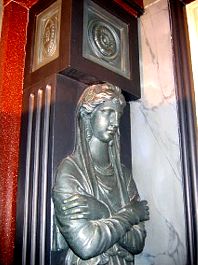
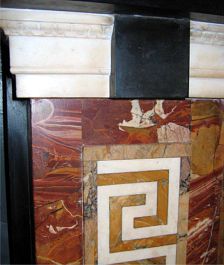
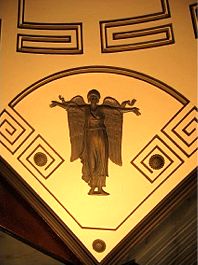
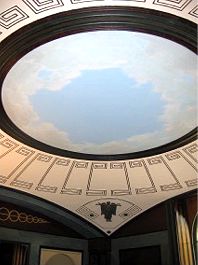 In
each of the corners of the room are caryatids and blocks, painted to look like bronze,
they are in fact 'Coade' stone supplied by 'Coade & Sealy' of Lambeth in 1802,
which the accounts show at a cost of £21.
In
each of the corners of the room are caryatids and blocks, painted to look like bronze,
they are in fact 'Coade' stone supplied by 'Coade & Sealy' of Lambeth in 1802,
which the accounts show at a cost of £21.
The low domed ceiling, has in the centre circle a painted sky with clouds around which is a striking black classical design which incorporates winged figures at each corner.
Double doors open out to the left through to the Library. The ceiling, which again is domed, is this time painted with a delicate trellis and flowers. A similar ceiling is to be found in his house in Lincoln's Inn and is a typical Soane's design. The walls are painted to resemble satinwood. He has used his passion for arches by including mirrored arches niches either side of the fireplace and the doors, which are of high proportions are also given an arched top. The fireplace is a Soane's design as is the incorporation of the huge plate glass mirror above set within a beaded frame.
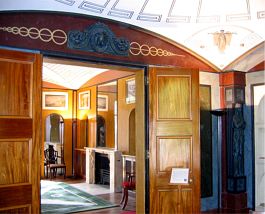
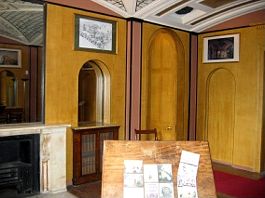
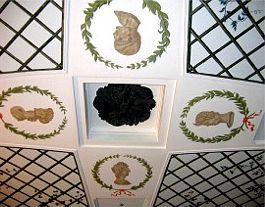
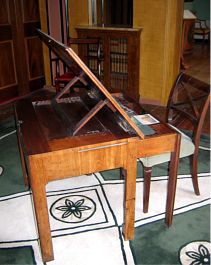
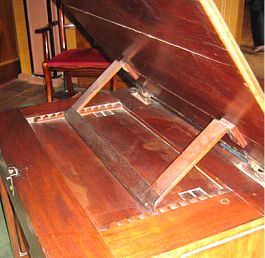 The
carpet on the floor in this room is a copy that echoes the shape and form of the
ceiling design, this was also true of the carpet in the Breakfast room. It is perhaps
poignant, that in this room stands a fine mid-eighteenth century architects table.
Soane may well have used such a table for producing his plans and designs. This
Chippendale period table is made of mahogany and has a pull out front section revealing
a table with room for drawing implements, etc. The table top lifts and can be set
to the angle required by a wooden support at the rear.
The
carpet on the floor in this room is a copy that echoes the shape and form of the
ceiling design, this was also true of the carpet in the Breakfast room. It is perhaps
poignant, that in this room stands a fine mid-eighteenth century architects table.
Soane may well have used such a table for producing his plans and designs. This
Chippendale period table is made of mahogany and has a pull out front section revealing
a table with room for drawing implements, etc. The table top lifts and can be set
to the angle required by a wooden support at the rear.
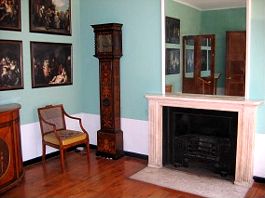
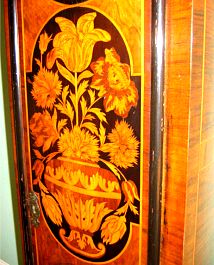 Turning
left out of the Library you enter the Small drawing room. The fireplace is again
a design by Soane and originally, there was a conservatory ran along the back of
the house which this room would have opened into, but this is no longer there. There
are a few very fine pieces of furniture in this pretty room, including a late eighteenth
century demi-lune satinwood commode. This has a very fine circular paintings
in the front panel in the style of Angelica Caughman. There are painted borders
of roses and morning glory enriching this piece. An early long case clock stands
in the corner, with beautiful marquetry floral panels within its case and an eighteenth
century secretair bookcase, with oval glass windows.
Turning
left out of the Library you enter the Small drawing room. The fireplace is again
a design by Soane and originally, there was a conservatory ran along the back of
the house which this room would have opened into, but this is no longer there. There
are a few very fine pieces of furniture in this pretty room, including a late eighteenth
century demi-lune satinwood commode. This has a very fine circular paintings
in the front panel in the style of Angelica Caughman. There are painted borders
of roses and morning glory enriching this piece. An early long case clock stands
in the corner, with beautiful marquetry floral panels within its case and an eighteenth
century secretair bookcase, with oval glass windows.
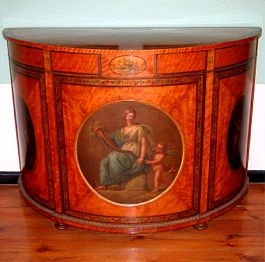
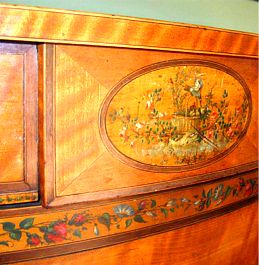
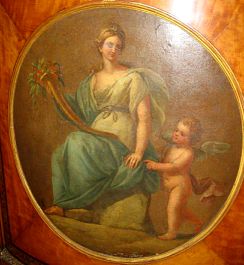
A set of Hogarth's paintings are hung in this room, as early accounts of the room list them as being hung here. This set is 'The Rakes Progress'. These are copies of the paintings, the originals painting are housed in the Soane's house in Lincoln's Inn Fields.
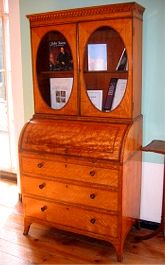
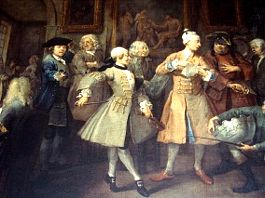
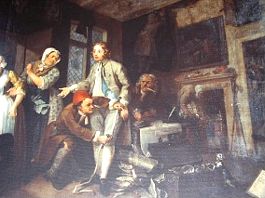
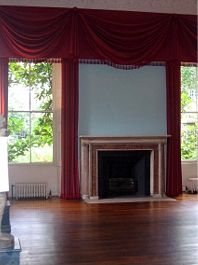
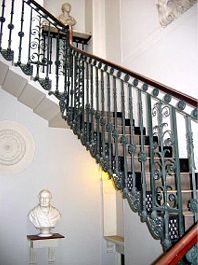 A
door from the Small Drawing room leads back into the Vestibule and to the Staircase
Hall. Through to the right beyond the Staircase is one of Charles Dance's rooms
which Soane retained, this the Eating Room. This is one of the larger rooms of the
house and was used for entertaining on a grand scale. The curtains are a copy taken
from a design of Soane for another house.
A
door from the Small Drawing room leads back into the Vestibule and to the Staircase
Hall. Through to the right beyond the Staircase is one of Charles Dance's rooms
which Soane retained, this the Eating Room. This is one of the larger rooms of the
house and was used for entertaining on a grand scale. The curtains are a copy taken
from a design of Soane for another house.
Retracing your steps to the Staircase Hall, the elegant cantilever stair case leads up to the first floor. An unusual feature of this staircase is pierced metal additions to the stone steps. A statue of Minerva graces the staircase wall. An oval skylight above the staircase floods the area with natural light.
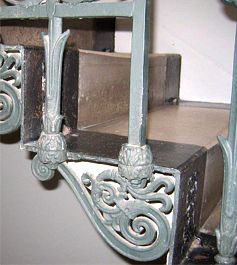
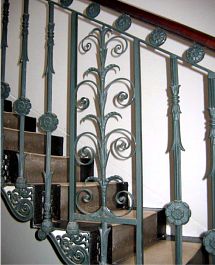
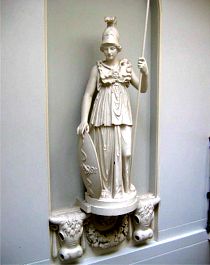
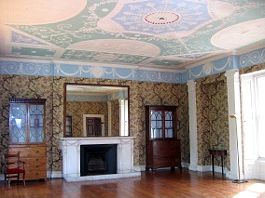
Turning right at the top of the stairs leads into the other large room, the work of Charles Dance, this the Drawing Room. As with the eating room below, this room was intended to be used on grand or formal occasions. there is a most elaborate moulded plaster ceiling, painted in bright colours and incorporating rustic scenes, including roundels portraying country tools such as a hay fork with chaffs of wheat.
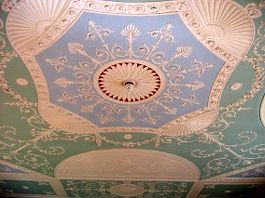
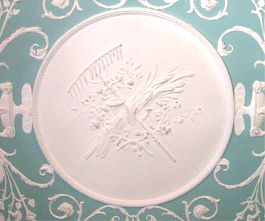
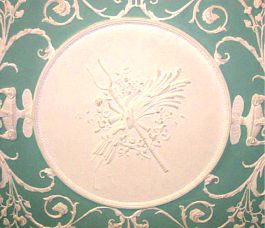
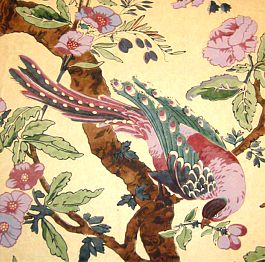 The
walls of the room are hung with a copy of an 1830's European wallpaper which was
copying Chinese hand painted wall paper. This brightly coloured paper depicts exotic
birds in braches of trees and is rather over powering, even in this large room.
A similar paper design was illustrated in a drawing of the room dating from 1832.
This room would have originally contained some more of Soane's impressive collection
of ancient statues, etc. and housed some fine furniture, no longer here. There are
two beautiful English Secretair bookcases standing at the far end of the
room, one with fine veneered oval window astragals, each door having a central rectangular
mirror in them. The other of mahogany and having arched shaped astragals and a moulded
relief round the top of the case.
The
walls of the room are hung with a copy of an 1830's European wallpaper which was
copying Chinese hand painted wall paper. This brightly coloured paper depicts exotic
birds in braches of trees and is rather over powering, even in this large room.
A similar paper design was illustrated in a drawing of the room dating from 1832.
This room would have originally contained some more of Soane's impressive collection
of ancient statues, etc. and housed some fine furniture, no longer here. There are
two beautiful English Secretair bookcases standing at the far end of the
room, one with fine veneered oval window astragals, each door having a central rectangular
mirror in them. The other of mahogany and having arched shaped astragals and a moulded
relief round the top of the case.
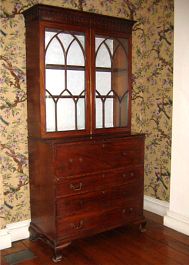
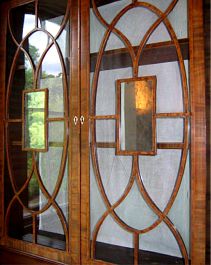
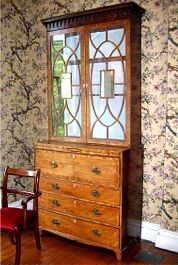
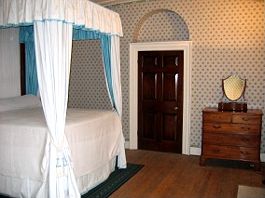 Moving
back out of the Drawing room on the other side of the staircase is a Bedchamber.
There are just four bedchambers on this first floor, none of which are of grand
proportions. Soane never intended his guests to stay overnight and indeed, he and
his wife would usually return to their Lincoln's Inn Field London house for the
night. This room shows the same cross barrel vaulted ceiling design as that of the
Library. The room now contains a four poster bed and chest of drawers on which stands
a shield shaped dressing table mirror. The shape of the drawer base has a beautiful
serpentine front and stands on shaped bracket feet. The drawers and top have very
fine chequered box and dark wood stringing, c1790. The wallpaper is of a period
design in blue and green with simple floral motif.
Moving
back out of the Drawing room on the other side of the staircase is a Bedchamber.
There are just four bedchambers on this first floor, none of which are of grand
proportions. Soane never intended his guests to stay overnight and indeed, he and
his wife would usually return to their Lincoln's Inn Field London house for the
night. This room shows the same cross barrel vaulted ceiling design as that of the
Library. The room now contains a four poster bed and chest of drawers on which stands
a shield shaped dressing table mirror. The shape of the drawer base has a beautiful
serpentine front and stands on shaped bracket feet. The drawers and top have very
fine chequered box and dark wood stringing, c1790. The wallpaper is of a period
design in blue and green with simple floral motif.
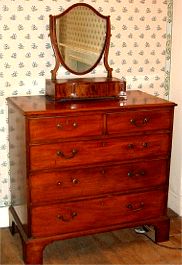
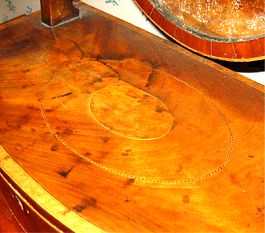
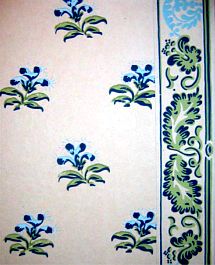
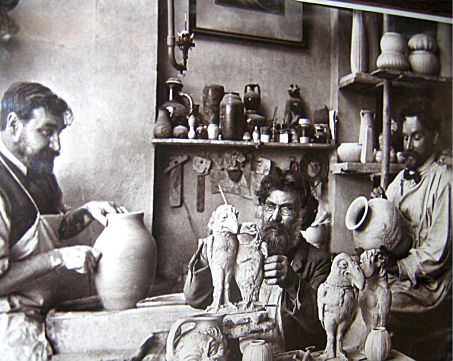
Returning downstairs and through the library to the later extension to the house, there is now housed in here an exhibition of pieces from the Martin Brothers Pottery in Southall and Fulham. The Martin brothers, Wallace, Walter, Edwin and Charles, born between 1843 and 1860, produced stoneware pottery which they produced and sold for over 40 years. Maybe some of their more recognisable pieces are their famous stoneware bird jars. But the exhibition shows some of their other items including clock cases, a garden fountain and many vases and even a teapot!
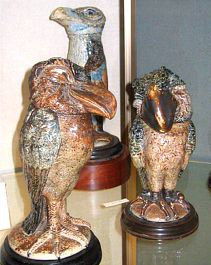
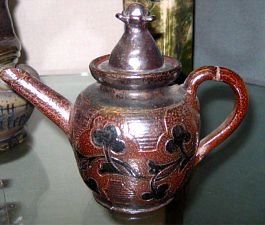
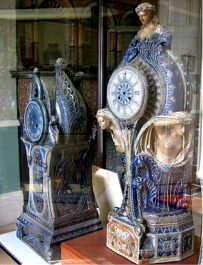
One very striking piece in the exhibition is a huge Martinware fireplace, 1891 This was commissioned for the billiard room at Buscot Park, Oxon by Alexander Henderson, later to become Lord Faringdon. His initials 'AF' and those of his wife are to be seen incorporated into the decorative design, one at each end of the fireplace. I will be paying a visit to Buscot Park in a later 'Tea Clipper'.
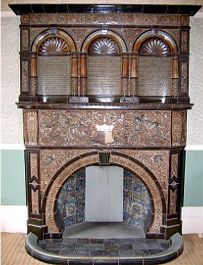
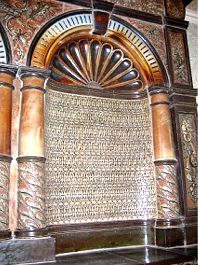
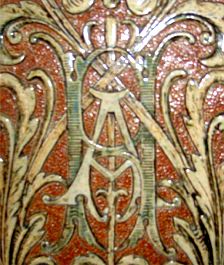
The later history of Pitzhanger Manor include it being a public Library and Reading room. Now in the hands of the council, it is being beautifully restored, with the aid of grants, to its former glory. Entry to the museum is free of charge and so can be enjoyed by all. It is an interesting house which contains many fascinating design features of the architect, Sir John Soane. In my opinion, well worth a visit and a place to which you can visit thought the winter months, not just the summer season.
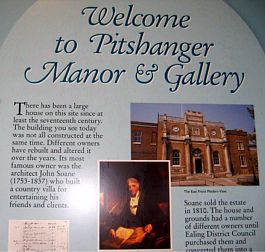
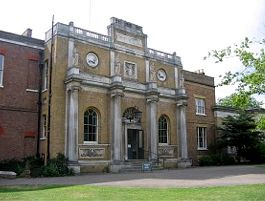
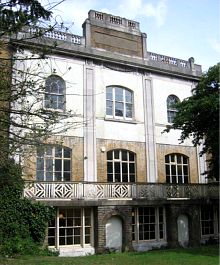
The gardens around the Manor are now an open public park, so their grander days have faded away, but again, this is an open space in which the local residents can enjoy themselves and the gardens.
Pitzhanger Manor Walpole Park Mattlock Lane Ealing W5 5EQ Tel: 020 8567 1227 Map: Click here
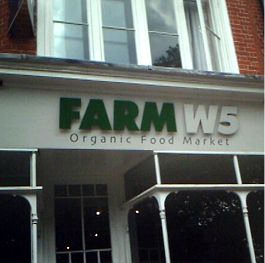
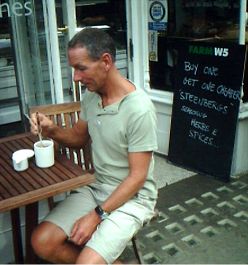 Sadly,
there is no tearoom at Pitzhanger Manor, but just across the road from the main
entrance, I discovered an interesting cafe / delicatessen - 'FARM W5' Here you can
sit inside (or out on the pavement) and enjoy some good home-made organic cakes,
sandwiches, bagels etc. Their coffees and teas are organic as is their food. Tempted
by what looked a delicious carrot cake, I resisted and went for a toasted buttered
bagel. This was buttered with rich Cornish butter. Sitting outside, you have a view
over to Pitzhanger Manor and can watch the world go by.
Sadly,
there is no tearoom at Pitzhanger Manor, but just across the road from the main
entrance, I discovered an interesting cafe / delicatessen - 'FARM W5' Here you can
sit inside (or out on the pavement) and enjoy some good home-made organic cakes,
sandwiches, bagels etc. Their coffees and teas are organic as is their food. Tempted
by what looked a delicious carrot cake, I resisted and went for a toasted buttered
bagel. This was buttered with rich Cornish butter. Sitting outside, you have a view
over to Pitzhanger Manor and can watch the world go by.
FARM W5
'organic food market'
19, The Green
Ealing
W5 5DA
Tel: 020 8566 1965
web-site: www.FarmW5.co.uk
Map:
Click here
To review past newsletters, just follow this link:
Past newsletters.
To subscribe to this free newsletter -
Click here